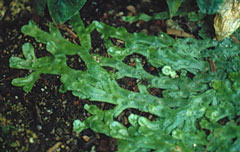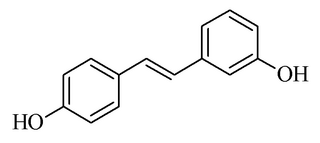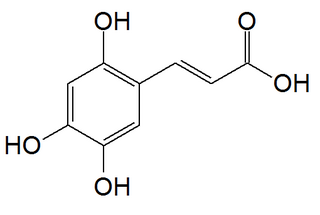
Sabinene is a natural bicyclic monoterpene with the molecular formula C10H16. It is isolated from the essential oils of a variety of plants including Marjoram, holm oak (Quercus ilex) and Norway spruce (Picea abies). It has a strained ring system with a cyclopentane ring fused to a cyclopropane ring.
Denitrobacterium is a genus of Actinobacteria with a single species, in the family Coriobacteriaceae. Originally isolated from the bovine rumen, Denitrobacterium are non-motile and non-spore forming. The only described species in this genus is Denitrobacterium detoxificans. The specific niche of this bacterium in the bovine rumen is theorized to be the detoxification/metabolism of nitrotoxins and miserotoxin.

Phenanthrenoids are chemical compounds formed with a phenanthrene backbone. These compounds occur naturally in plants, although they can also be synthesized.

Malvin is a naturally occurring chemical of the anthocyanin family.
Phytoecdysteroids are plant-derived ecdysteroids. Phytoecdysteroids are a class of chemicals that plants synthesize for defense against phytophagous insects. These compounds are mimics of hormones used by arthropods in the molting process known as ecdysis. When insects eat the plants with these chemicals they may prematurely molt, lose weight, or suffer other metabolic damage and die.

Perrottetinene is a naturally occurring cannabinoid compound found in liverworts from the genus Radula native to Japan, New Zealand and Costa Rica, namely Radula perrottetii, Radula marginata and Radula laxiramea, along with a number of similar compounds. Its chemical structure closely resembles that of THC, the main active component of marijuana. The absolute configuration of perrottetinene was established in 2008 by an enantioselective total synthesis. In 2018, a study showed that perrottetinene is moderately psychoactive through activation of the cannabinoid receptor 1. The same study also reported reduced prostaglandin D2 and E2 brain concentrations in mice after perrottetinene administration.

Catalpol is an iridoid glucoside. This natural product falls in the class of iridoid glycosides, which are simply monoterpenes with a glucose molecule attached.

A xanthonoid is a chemical natural phenolic compound formed from the xanthone backbone. Many members of the Clusiaceae contain xanthonoids.

Astringin is a stilbenoid, the 3-β-D-glucoside of piceatannol. It can be found in the bark of Picea sitchensis or Picea abies.

Dihydrostilbenoids (bibenzyls) are natural phenols formed from the dihydrostilbene (bibenzyl) backbone.

Conocephalum conicum, the great scented liverwort, common mushroom-headed liverwort or snakeskin liverwort, is a liverwort species in the genus Conocephalum .

Violdelphin is an anthocyanin, a plant pigment, has been found in the purplish blue flower of Aconitum chinense, in the blue flowers in the genus Campanula and in the blue flowers of Delphinium hybridum. It is a flavenoid natural product, incorporating two p-hydroxy benzoic acid residues, one rutinoside and two glucosides associated with a delphinidin.

3,4′-Dihydroxystilbene is a stilbenoid found in the roots of Hydrangea macrophylla.
Lunularic acid decarboxylase is an enzyme that converts lunularic acid into lunularin.

Lunularin is a dihydrostilbenoid found in common celery. It has also been found in the roots of Hydrangea macrophylla.
Omega-hydroxypalmitate O-feruloyl transferase is an enzyme with systematic name feruloyl-CoA:16-hydroxypalmitate feruloyltransferase. This enzyme catalyses the following chemical reaction

Isoscutellarein is a flavone found in Cupuaçu and in the liverwort Marchantia berteroana.

Marchantia berteroana is a liverwort species in the genus Marchantia.

Hypolaetin is a flavone. It is the aglycone of hypolaetin 8-glucuronide, a compound found in the liverwort Marchantia berteroana. Hypolaetin 8-glucoside can be found in Sideritis leucantha.

2,4,5-Trihydroxycinnamic acid is a hydroxycinnamic acid found in rooibos tea. cis-2,4,5-Trihydroxycinnamic acid can be isolated from seeds of Alisma orientale.
















